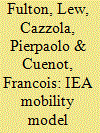|
|
|
Sort Order |
|
|
|
Items / Page
|
|
|
|
|
|
|
| Srl | Item |
| 1 |
ID:
118816


|
|
|
|
|
| Publication |
2013.
|
| Summary/Abstract |
This paper identifies trends in new gasoline and diesel passenger car characteristics in the European Union between 1995 and 2009. By 2009 diesels had captured over 55% of the new vehicle market. While the diesel version of a given car model may have as much as 35% lower fuel use/km and 25% lower CO2 emissions than its gasoline equivalent, diesel buyers have chosen increasingly large and more powerful cars than the gasoline market. As a result, new diesels bought in 2009 had only 2% lower average CO2 emissions than new gasoline cars, a smaller advantage than in 1995. A Laspeyres decomposition investigates which factors were important contributors to the observed emission reductions and which factors offset savings in other areas. More than 95% of the reduction in CO2 emissions per km from new vehicles arose because both diesel and gasoline new vehicle emissions/km fell, and only 5% arose because of the shift from gasoline to diesel technology. Increases in vehicle mass and power for both gasoline and diesel absorbed much of the technological efficiency improvements offered by both technologies. We also observe changes in the gasoline and diesel fleets in eight EU countries and find changes in fuel and emissions intensities consistent with the changes in new vehicles reported. While diesel cars continue to be driven far farther than gasoline cars, we attribute only some of this difference to a "rebound effect". We conclude that while diesel technology has permitted significant fuel savings, the switch from gasoline to diesel in the new vehicle market contributed little itself to the observed reductions in CO2 emissions from new vehicles.
|
|
|
|
|
|
|
|
|
|
|
|
|
|
|
|
| 2 |
ID:
091517


|
|
|
|
|
| Publication |
2009.
|
| Summary/Abstract |
The IEA published "Energy Technology Perspectives" (ETP) in June 2008. That document reports on IEA scenarios for baseline and low-CO2 alternative scenarios to 2050, across the energy economy. The study included creating scenarios for transport, using the IEA Mobility Model (MoMo). This paper reports on the transport-related ETP scenarios and describes the model used in the analysis. According to the ETP Baseline scenario, world transport energy use and CO2 emissions will more than double by 2050. In the most challenging scenario, called "BLUE", transport emissions are reduced by 70% in 2050 compared to their baseline level in that year (and about 25% below their 2005 levels). There are several versions of the BLUE scenario, but all involve: a 50% or greater improvement in LDV efficiency, 30-50% improvement in efficiency of other modes (e.g. trucks, ships and aircraft), 25% substitution of liquid fossil fuels by biofuels, and considerable penetration of electric and/or fuel-cell vehicles. In the second half of this paper, an overview of the MoMo model is provided. Details on the complete analysis are contained in the ETP 2008 document, available at www.iea.org. Details of the LDV fuel economy analysis are contained in a separate paper in this collection.
|
|
|
|
|
|
|
|
|
|
|
|
|
|
|
|
| 3 |
ID:
111319


|
|
|
|
|
| Publication |
2012.
|
| Summary/Abstract |
Travel statistics for most countries are subject to numerous uncertainties. But as presented in this paper, the IEA has developed a sufficient database to estimate passenger travel by mode for major countries and regions around the world, and produce consistent travel and energy use estimates, perhaps the first of their kind. For example, we estimate that in 2005 total global passenger travel using motorised modes was about 40 trillion kilometres, or about 6000 per person. The IEA has also developed a set of travel projections to 2050, including a Baseline and a "Modal Shift" scenario. This paper provides the result of this analysis and estimates the potential impacts on CO2 from a 25% reduction in car and air travel by 2050 relative to the Baseline in that year. The modelling effort and policy analysis used to support the findings are also described.
|
|
|
|
|
|
|
|
|
|
|
|
|
|
|
|
| 4 |
ID:
150402


|
|
|
|
|
| Summary/Abstract |
This paper examines three technology routes for lowering the carbon intensity of biofuels: (1) a leapfrog route that focuses on major technological breakthroughs in lignocellulosic pathways at new, stand-alone biorefineries; (2) an incremental route in which improvements are made to existing U.S. corn ethanol and soybean biodiesel biorefineries; and (3) a transitional route in which biotechnology firms gain experience growing, handling, or chemically converting lignocellulosic biomass in a lower-risk fashion than leapfrog biorefineries by leveraging existing capital stock. We find the incremental route is likely to involve the largest production volumes and greenhouse gas benefits until at least the mid-2020s, but transitional and leapfrog biofuels together have far greater long-term potential. We estimate that the Renewable Fuel Standard, California's Low Carbon Fuel Standard, and federal tax credits provided an incentive of roughly $1.5–2.5 per gallon of leapfrog biofuel between 2012 and 2015, but that regulatory elements in these policies mostly incentivize lower-risk incremental investments. Adjustments in policy may be necessary to bring a greater focus on transitional technologies that provide targeted learning and cost reduction opportunities for leapfrog biofuels.
|
|
|
|
|
|
|
|
|
|
|
|
|
|
|
|
|
|
|
|
|